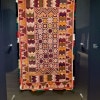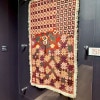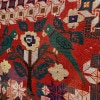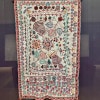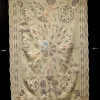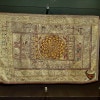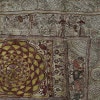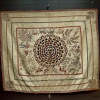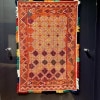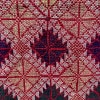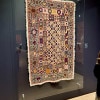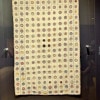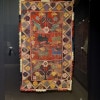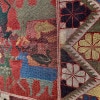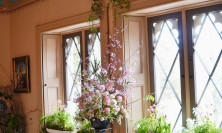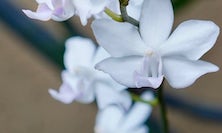Bengal Cross-Stitch Quilts
From the exhibition:
Cross-Stitch in Bengal
The global history of cross-stitch spans thousands of years but its use in 1800s Bengal seems linked to British colonialism.
European women had long decorated their linens with cross-stitch and by the 1700s often learned the technique by making a type of sampler that was also a tool for basic literacy (photo of a later Bengali version at left). Although female Christian missionaries taught in wealthy homes and missionary-run girl's schools, many Bengalis, both Hindu and Muslim, remained wary of Christian conversion. Men also debated whether girls should be educated at all.
Galichas may also have been inspired by another practice called Berlin work, a fad brought to India by British women.Usually done in cross-stitch and conveyed by paper patterns printed on a grid (see case below), these cloths often display geometric patterns in the bright colors of new artificial dyes. Berlin work covers the surface of the canvas, making it stronger so that it could be used for furnishings, shoes, and rugs. But it seems to have taken decades for cross-stitch to move into the regular vocabulary of domestic Bengali kantha making. Filling in the steps of that history awaits further exploration.
And:
Nakshi & Galicha Kanthas
Historical nakshi kanthas may display over twenty stitch types, including running stitch (top photo at left), but only later examples incorporate cross-stitch into their repertoire.
Galicha kanthas, on the other hand, are completely done in cross-stitch. Usually, the two diagonal (crossed) threads are overlaid with a third (couching) stitch to hold them in place (bottom photo at left). Although called galicha (carpet) kanthas, this type was commonly used on low beds rather than as floor coverings. Their name probably comes from the heavy carpet needle used to pierce these thick quilts.
Like quilts around the world, kanthas embody thrift, labor, and imagination. Women in Bengal (modern-day Bangladesh and the state of West Bengal, India) created kanthas for a host of reasons—as ritual seating, bedcovers, baby swaddling, and much more. Most disintegrated with household use, but many that survived are now heirlooms that carry women's individuality and love for their families across generations.
This exhibition brings into conversation two types of kanthas: nakshi (ornamented) kanthas and galicha (carpet) kanthas. The nakshi kanthas on view, from between about 1870 and 1930, are made on layers of soft, white, repurposed fabric embroidered with meaningful motifs in a delicate palette and often covered with rows of parallel white running stitches. Galicha kanthas, produced especially in the 1950s and 1960s, are thick, uniformly rectangular quilts with vivid cross-stitch embroidery in intricate geometric forms on a surface of new cloth backed by upcycled fabrics.
